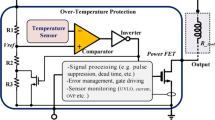Abstract
Herein is presented a battery management chip without external charging and discharging MOSFETs that promotes the miniaturization of wearable devices and reducing the size of battery management system on printed circuit boards (PCBs). The battery management chip is designed to integrate the discrete charging and discharging MOSFETs into the chip, even removing current sense resistor significantly. Using the proposed adaptive substrate selecting (ASS) technology, the same protection function of the traditional battery management chip is realized, which greatly saves the area cost of the chip. Based on the 0.18 μm 5 V process, the circuit and the switch have been integrated into a single lithium battery management chip. The measurements show that the chip can reliably protect the battery from overvoltage, under voltage and overcurrent with low power consumption.









Similar content being viewed by others
Data Availability
The datasets analyzed during the current study are available from the corresponding author on reasonable request.
References
Wuthibenjaphonchai, N., Haruta, M., Sasagawa, K., et al. (2021). Wearable and Battery-free Health-monitoring Devices with Optical Power Transfer[J].IEEE Sensors Journal, PP (99):1–1
Ueafuea, K., Boonnag, C., Sudhawiyangkul, T., et al. (2020). Potential Applications of Mobile and Wearable Devices for Psychological Support During the COVID-19 Pandemic: A Review[J].IEEE Sensors Journal, PP (99):1
Amirshahi, A., & Hashemi, M. E. C. G. (2020). Classification Algorithm Based on STDP and R-STDP Neural Networks for Real-Time Monitoring on Ultra Low-Power Personal Wearable Devices[J]. IEEE Transactions on Biomedical Circuits and Systems, 13(6), 1483–1493
Chowdhury, D., & Chattopadhyay, M. (2020). Development of a Low-Power Microcontroller-Based Wrist-Worn Device with Resource-Constrained Activity Detection Algorithm[J].IEEE Transactions on Instrumentation and Measurement, PP (99):1–1
Song, S., Konijnenburg, M., Wegberg, R. V., et al. (2020). A 769 µW Battery-Powered Single-Chip SoC With BLE for Multi-Modal Vital Sign Monitoring Health Patches[J]. IEEE Transactions on Biomedical Circuits and Systems, 13(6), 1506–1517
Lukas, C. J., Yahya, F. B., Breiholz, J., et al. (2019). A 1.02 µW Battery-Less, Continuous Sensing and Post-Processing SiP for Wearable Applications[J].IEEE Transactions on Biomedical Circuits and Systems, :271–281
Dini, M., Romani, A., Filippi, M., et al. (2015). A Nanocurrent Power Management IC for Multiple Heterogeneous Energy Harvesting Sources[J]. IEEE Transactions on Power Electronics, 30(10), 5665–5680
Lee, S., Jeong, Y., Song, Y., & Kim, J. (2014). “A single chip Li-Ion battery protection IC with low standby mode auto release,“ 2014 International SoC Design Conference (ISOCC), pp. 38–39, doi: https://doi.org/10.1109/ISOCC.2014.7087583
Wang, Y., Han, Z., & Shi, J. One cell Lithium-ion battery protection IC[C]//Industrial Electronics & Applications. IEEE, 2014:1427–1432
Wu, K. K., Wang, H. Y., Chen, C., et al. (2021). Improved voltage transfer method for lithium battery string management chip[J]. Iet Circuits, Devices And Systems, 1–8. https://doi.org/10.1049/cds2.12060
DS2764 Data (2019). Sheet, Maxim Incorporated, Sunnyvale, CA,
BQ2982 Data Sheet (2021). Texas Instruments Inc., Dallas, TX,
Inoue, H., et al. (2019). “Micro Short-Circuit Detector Including S/H Circuit for 1hr Retention and 52dB Comparator Composed of C-Axis Aligned Crystalline IGZO FETs for Li-Ion Battery management chip,“ 2019 IEEE International Solid- State Circuits Conference - (ISSCC), San Francisco, CA, USA, pp. 204–206
BQ2970 Data Sheet (2021). Texas Instruments Inc., Dallas, TX,
Seunghyeong, L. (2015). Yongjae, et al. A Low-Power Single Chip Li-Ion Battery Protection IC[J]. Journal of Semiconductor Technology & Science
Acknowledgements
This research was sponsored by Joint Foundation of Key Laboratory of Shanghai Jiao Tong University-Xidian University, Ministry of Education under Grant LHJJ/2020-05.
Author information
Authors and Affiliations
Corresponding author
Ethics declarations
Conflict of interest
The authors declare that they have no known competing fnancial interests or personal relationships that could have appeared to infuence the work reported in this paper.
Additional information
Publisher’s Note
Springer Nature remains neutral with regard to jurisdictional claims in published maps and institutional affiliations.
Rights and permissions
Springer Nature or its licensor holds exclusive rights to this article under a publishing agreement with the author(s) or other rightsholder(s); author self-archiving of the accepted manuscript version of this article is solely governed by the terms of such publishing agreement and applicable law.
About this article
Cite this article
Wu, KK., Wang, HY., Chen, C. et al. A highly integrated one cell battery management chip for wearables. Analog Integr Circ Sig Process 113, 393–401 (2022). https://doi.org/10.1007/s10470-022-02101-3
Received:
Revised:
Accepted:
Published:
Issue Date:
DOI: https://doi.org/10.1007/s10470-022-02101-3




